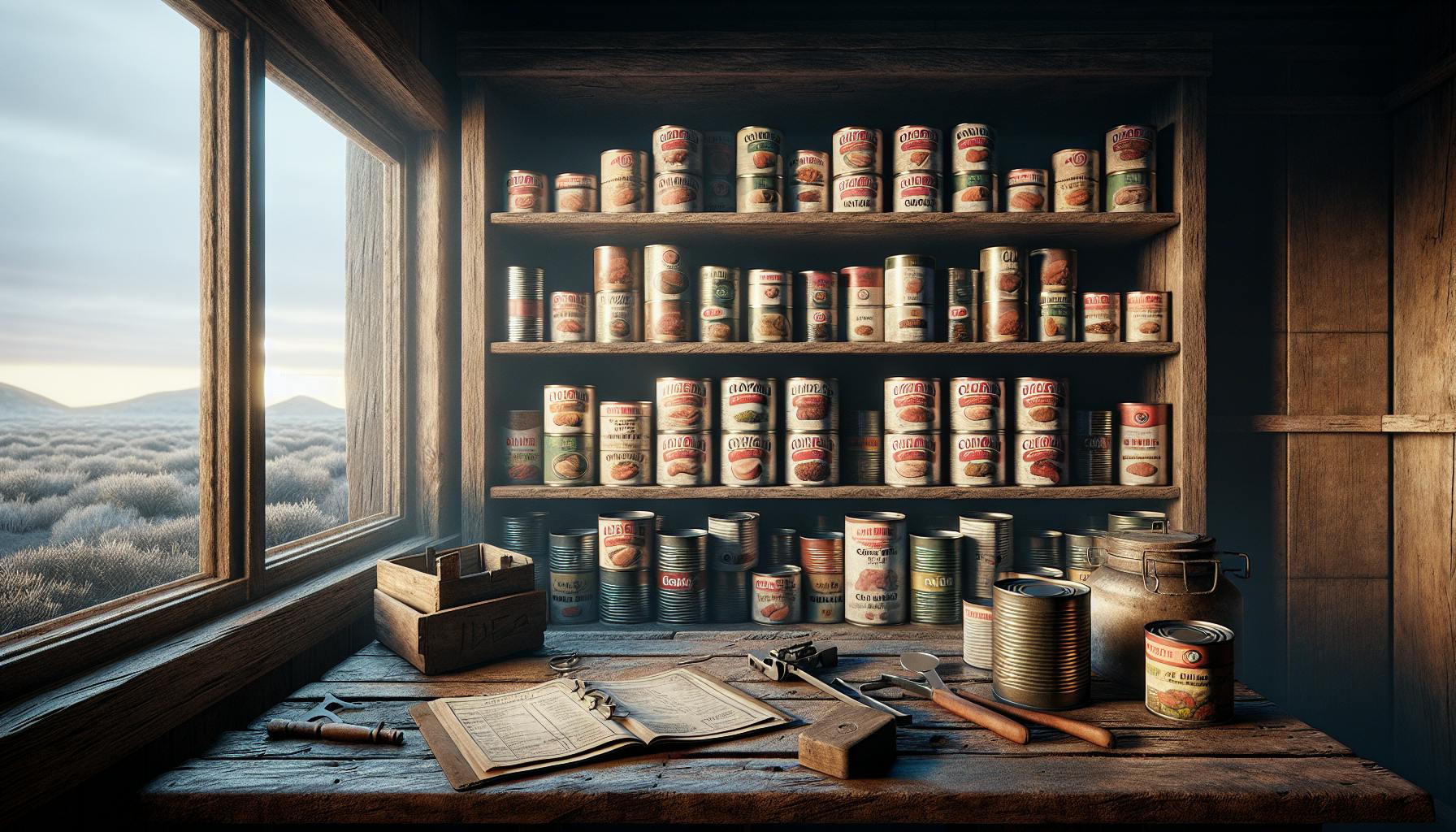When building an emergency food supply, most people would agree that freeze dried foods check all the boxes: lightweight, nutritious, easy to store, and long lasting.
In this post, you'll discover the essential freeze dried foods to stock your emergency pantry for balanced nutrition and a 25-year shelf life.
You'll learn how freeze drying locks in nutrients while eliminating weight and bulk, the specific foods that provide complete proteins and healthy fats, and tips for storage and rotation to keep your supply fresh for decades to come.
Introduction to Freeze Dried Emergency Food
Freeze dried foods are essential for emergency preparedness kits due to their extended shelf life and nutritional quality. The freeze drying process allows foods to retain more nutrients compared to other preservation methods. When water is removed, freeze dried foods become lightweight and compact yet reconstitute into a nutritious meal with just the addition of hot water.
Understanding the Freeze Drying Process
Freeze drying works by freezing foods then reducing pressure to allow the frozen water in the food to sublimate directly from the solid phase to the gas phase. This dramatic removal of water content slows down food degradation reactions that lead to spoilage. Foods shrink in size but maintain their original shape. When water is added back, foods return to their original form within minutes.
Nutritional Advantages of Freeze Dried Foods
With only the water removed, freeze dried foods offer balanced macro and micronutrients essential for health. The process preserves the quality of proteins, fats, carbohydrates, vitamins and minerals. The resulting food is nutritionally comparable to fresh foods, delivering energy and nutrients vital in an emergency when access to perishable produce is limited.
The 25-Year Emergency Food Supply Advantage
Properly stored freeze dried foods can remain edible for 25+ years. The extremely low moisture content prevents microbial growth and slows oxidative reactions. Food is sealed in moisture-proof packaging then stored in a cool, dark place to achieve multi-year shelf stability. Having an extensive emergency food supply ensures your family won't go hungry if a disaster lasts weeks or months.
Portability: Lightweight & Compact Solutions
Because only water is removed, freeze dried foods weigh significantly less. Small pouches easily fit into bug out bags, emergency kits, and tight storage spaces. Even a years' supply takes up minimal room relative to canned or other preserved foods. The lightweight quality offers superior portability if evacuation becomes necessary.
Simplicity in Preparation
Reconstituting freeze dried food only requires adding near-boiling water, waiting 5-10 minutes, then eating. No refrigeration, cooking skills, or kitchen tools needed. Simple preparation allows quick meals ideal for chaotic disaster scenarios when utilities may be compromised. Just add water for nutritious sustenance.
Best Freeze Dried Emergency Food Selection
When building an emergency food supply, it's important to select freeze dried meals and ingredients that meet key criteria for nutrition, taste, and shelf life. Here are some tips:
Key Considerations for High-Calorie Meals
- Benchmark 2,000-2,500 calories per person per day for emergency food kits
- Prioritize freeze dried entrees and sides with higher calorie counts
- Choose meal pouches that list calories per serving on packaging
Assessing Macronutrient and Micronutrient Profiles
- Seek out meals with balanced ratios of protein, fat, and complex carbs
- Check vitamin and mineral levels to avoid deficiency over time
- Compare nutrition labels between different food kits
Selecting Quality Ingredients in Emergency Food Kits
- Look for whole, natural ingredients without artificial additives
- Confirm kits are free of GMOs for better nutrition
- Favor recognizable, minimally processed foods
Taste Testing: Ensuring Palatable Meals
- When possible, sample or read reviews on taste
- Freeze dried foods should resemble fresh flavors and textures
- Having palatable meals boosts morale in stressful situations
Packaging for Longevity: Maximizing Shelf Life
- Select pouches using high-barrier film technology
- Verify multi-year shelf lives with manufacturer date stamping
- Properly storing kits avoids compromising shelf life
Choosing freeze dried emergency food kits with the right nutritional content, ingredients, and packaging ensures your food supply will be there when you need it most. Taste testing meals and reading online reviews can further guarantee palatable, morale-boosting meals for emergency situations.
Core Components of a 25-Year Emergency Food Supply
This section highlights essential freeze dried items to include in any emergency food supply based on nutritional profile, versatility, and ability to combine into balanced meals.
Vital Freeze Dried Fruits & Vegetables
Freeze dried fruits and vegetables like carrots, peas, corn, apples and strawberries are vital components of an emergency food supply. When reconstituted, they provide essential vitamins, minerals and fiber. Focus on produce that is nutrient-dense and has a long shelf life when freeze dried.
Prioritize fruits and vegetables that:
- Offer a range of vitamins and minerals like Vitamin A, Vitamin C, iron and potassium
- Rehydrate well after being freeze dried
- Can be eaten on their own or incorporated into meals
- Have a shelf life of 20+ years when stored properly
Protein-Rich Beans & Legumes
Beans and legumes like black beans, lentils and chickpeas are excellent additions to an emergency food supply. They supply protein, fiber and key micronutrients. Canned or freeze dried options have long shelf lives.
Ideal beans and legumes to include are:
- Black beans
- Kidney beans
- Chickpeas
- Lentils
- Pinto beans
When reconstituted, these foods can be used to make chili, bean soup, tacos, hummus and more, adding nutrition and stretching other ingredients.
Dairy Alternatives: Powdered Milk and Eggs
Powdered milk and eggs provide protein, calcium and other nutrients often lacking in freeze dried meal components.
Powdered milk can be reconstituted into a beverage or incorporated into recipes. Opt for whole milk powder with a 20+ year shelf life.
Powdered eggs replace fresh eggs in meals like omelets, quiches and pancakes. Choose powdered eggs that have been pasteurized to reduce food safety risks.
Selecting Quality Freeze Dried Meats
When buying freeze dried meats like chicken, beef or fish, prioritize:
- High protein content (at least 18g per serving)
- Lean cuts over fatty options
- Moist, tender texture once rehydrated
- Packaging that protects against oxidation
Use rehydrated meats in stews, sandwiches, tacos and more. Combine with vegetables, beans and grains to stretch further.
Incorporating Grains for Energy and Satiety
Finally, no emergency food supply is complete without grains like rice, oats, pasta and quinoa. These provide carbohydrates for energy and feelings of fullness.
Opt for whole grains when possible for added nutrition. White rice has a very long shelf life but enriche options add back some B vitamins lost in processing.
Grains are versatile - cook simply with some freeze dried veggies or get creative with rice pilaf, oatmeal and more.
sbb-itb-b932644
Crafting Balanced Meals with Freeze Dried Foods
This section provides suggestions for combining different freeze dried components into nutritionally complete, appetizing meals.
Starting the Day Right: Breakfast Ideas
Examples of oatmeal, scrambled eggs with veggies, granola with milk, breakfast burritos and other morning meal options.
-
Oatmeal: Combine freeze dried fruits like strawberries, blueberries, or bananas with instant oatmeal packets. Add nuts or chia seeds for extra nutrition.
-
Scrambled eggs: Rehydrate freeze dried vegetables like peppers, onions, mushrooms to mix into egg scramble. Add cheese or meat for protein.
-
Granola bowls: Mix freeze dried yogurt or milk with granola cereal. Top with freeze dried fruit.
-
Breakfast sandwiches/burritos: Combine rehydrated eggs, cheese, meat and veggies into breakfast sandwich or wrap.
Nourishing Lunch & Dinner Combinations
Ideas for soups, chilis, rice bowls, skillet meals using suggested food item combinations.
-
Chili: Use freeze dried ground beef, beans, corn, tomatoes, peppers and seasonings to make hearty chili. Can eat as-is or serve over rice.
-
Rice bowls: Make simple fried rice with freeze dried carrots, peas, corn, eggs. Add soy sauce or teriyaki and protein like chicken.
-
Skillet meals: Sauté rehydrated meat and veggies like chicken, broccoli, carrots. Serve over pasta or rice.
-
Hearty soups: Combine freeze dried veggies, beans, pasta and broth into minestrone, vegetable soup, chicken noodle variations.
Snacks & Desserts: Satisfying Cravings
Overview of sweet and savory snacks like trail mixes, jerky, applesauce, puddings to round out nutrition.
-
Trail/snack mixes: Make DIY blends with freeze dried fruits, pretzels, chocolate chips, nuts, seeds.
-
Fruit snacks: Rehydrate freeze dried apple slices, strawberries, pineapple. Dip in chocolate or yogurt.
-
Puddings: Mix freeze dried milk with instant pudding mix. Top with crushed cookies or graham crackers.
-
Jerky and bars: Keep on hand for protein, fiber when need a filling, nutrient-dense snack.
Optimizing Storage for a 25-Year Shelf Life
This section provides guidelines on ideal storage conditions to achieve multi-year shelf lives for freeze dried emergency food kits.
Storing in a Cool & Dry Environment
To maximize shelf life, store food kits in a cool, dry place with temperatures between 55-70°F. Low humidity environments prevent moisture damage. Consider storing kits in a basement, closet, or temperature-controlled pantry if possible.
Protecting Food with Opaque Containers
Limit light and oxygen exposure by storing pouches in Mylar bags, buckets with gasket seals, or using oxygen absorbers. This prevents oxidation and nutrient degradation over time. Opaque storage helps ensure your emergency food supply retains maximum nutritional value.
Handling Tips to Preserve Integrity
When accessing or transporting pouches, avoid crushing, puncturing, or putting excess pressure on kits. This protects the integrity of the packaging and seals. Carefully stack flat or utilize protective bins. Check seals before storage and after access.
Rotating Stock: First Expiring, First Out
Label each pouch with the expiration date and follow "first expiring, first out" guidelines. Use up oldest kits first by integrating into your pantry rotation. Then replace them with new emergency food so you always maintain fresh 25-year emergency food supply.
Conclusion: Preparing for the Long Term with Freeze Dried Emergency Food
To conclude, freeze dried foods can make all the difference in an emergency when fresh produce and meat are inaccessible. Focusing on nutritionally balanced kits with fruits, vegetables, dairy, beans, grains and meat can set you up with wholesome meals for years.
Pairing freeze dried emergency food with proper cool, dry storage will help retain maximum nutrition and shelf life when you need it most. Some key tips:
- Store food in a basement, root cellar, or temperature controlled area between 50-70°F. Avoid attics, garages, or areas with extreme temperature fluctuations
- Use oxygen absorbers and quality sealable containers certified for long term food storage
- Organize by expiration date and rotate stock using the FIFO (First In, First Out) method
- Consider large #10 cans which seal out oxygen better than plastic buckets or pouches
Having a diverse, nutritious stockpile with 5+ years of calories per person takes the stress out of any disaster scenario. Freeze dried emergency food lets you focus on more pressing needs, knowing you have long term sustenance covered.


